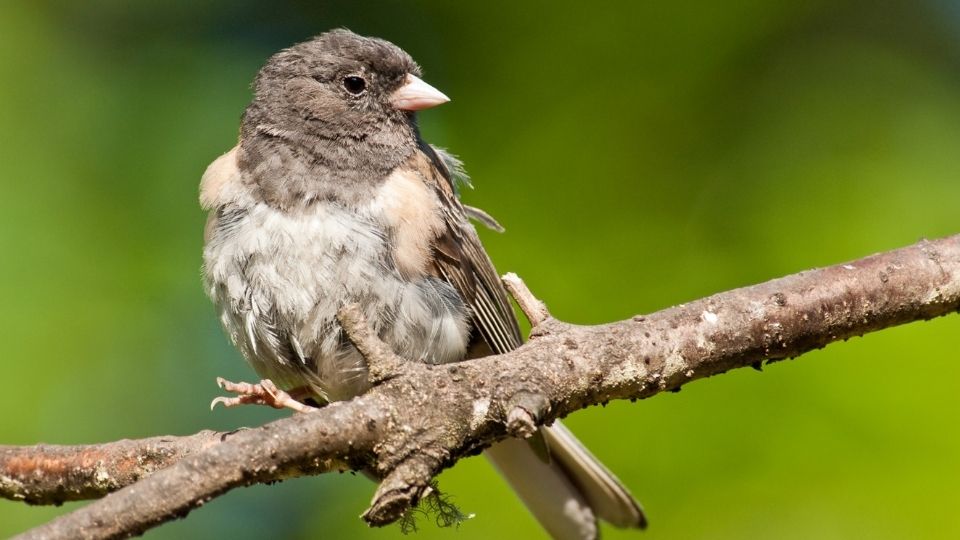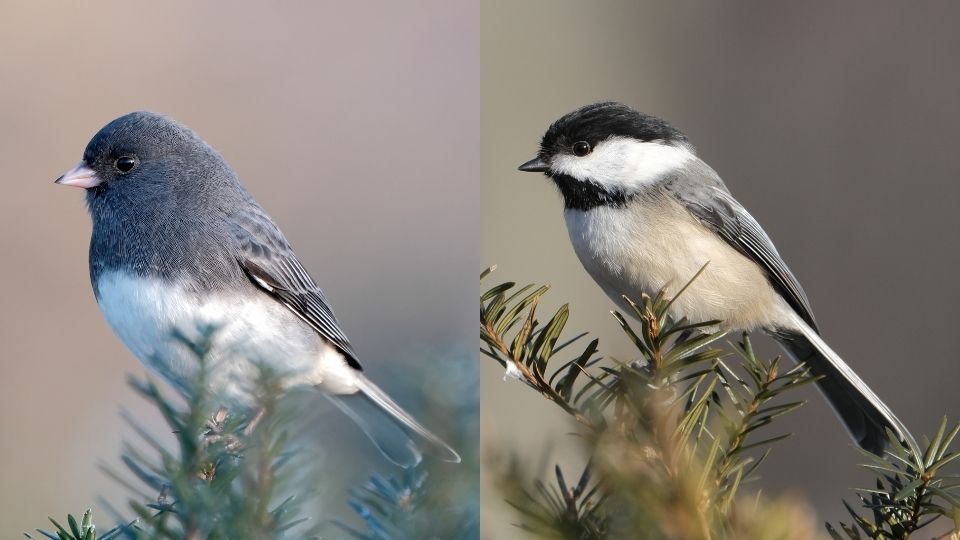To tell the difference between a junco vs chickadee, look at the features by the beak of the bird. Most juncos have light colored bills ranging from light grey to pinkish white. All seven species of chickadees generally have dark bills that are black, and a very distinct contrasting white stripe on their cheeks and neck.
Can’t tell the difference between a Chickadee and a Junco? You are certainly not alone. Even seasoned bird watchers and ornithologists have a tricky time telling the difference between these two songbirds at a glance.
Juncos come from the Passerellidae family, and are categorized under the Junco genus which contain 13 sub-species of songbirds. This includes Dark-eyed juncos and Yellow-eyed juncos. There are 7 subspecies of Chickadees, that include species like the Black-capped chickadee and the Grey-headed chickadee.
Using clues like size and the color of feathers, location, and habitat can help birders differentiate between juncos and chickadees – but sometimes, it’s not that simple. While spotting the Chickadee is straightforward, things get pretty complicated regarding the dark-eyed Junco. Let’s dive into the differences between these birds so you can easily detect who is visiting your backyard bird feeders.
Coloring
The easiest way to differentiate between these two very similar birds is by observing the patterns of their feathers. While both birds come in many colors like black, white, and gray, there are a few key features that make them easier to spot.
Chickadee – The Chickadee’s most notable feature is its black cap on its head and tiny little black bib. It has a blend of blue-ish gray feathers that make its black features stand out in a snowstorm.
Some, but not all, have subtle accents of rust-colored feathers below its wings and streaky black and white downy feathers. They also have a black beak, which is another easy way to identify them.
Junco – The Dark-Eyed Junco has similar black, white, and gray feathers with crucial differences. Overall, The Dark-Eyed Junco has more black and dark gray coloring than the Chickadee. Their heads are almost entirely black (or dark gray), which makes their eyes look lost in dark feathers.
While their eyes get lost in their black feathers, their pink beak stands out. Unlike Chickadees with black beaks, the stunning pink beak of a Junco is an easy way to spot the difference.
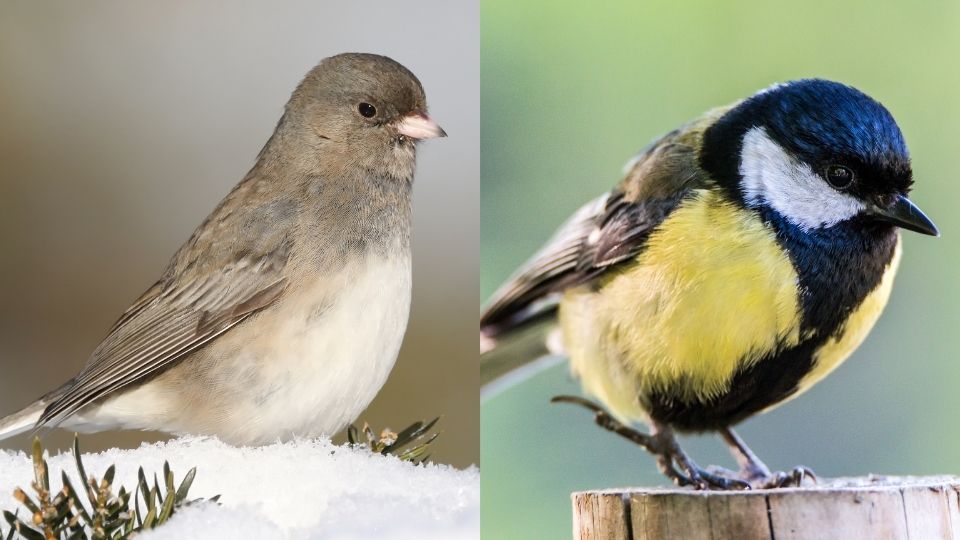
Size
At a glance, the Black-Capped Chickadee and Dark-Eyed Junco are very similar in size. However, Junco’s are only slightly larger than the Chickadee.
Chickadee – The Chickadee is one of the smallest songbirds in North America. It measures between 3.9-4.7 inches long with a 5.9-7.9 inch wingspan. Weighing in at just 12 grams, which is about the weight of a single AAA battery!
Junco – The Dark-Eyed Junco is larger than a Black-Capped Chickadee, but not by much. An average Junco measures 5.5-6.3 inches long with a wingspan of between 7.1-9.8 inches. They weigh 18-30 grams, about as heavy as a lightbulb.
Habitat
One easy way to identify these small birds lies in their habitats. Both birds reside in North America, but there are only a few places where their habitats overlap. There are certain parts in North America where Chickadees are not found, but Juncos are.
Chickadee – Chickadees primarily make their homes in lush deciduous forests in cooler climates. They have larger populations in the Northern part of the United States around the Great Lakes and much of Canada (and even as high up as Alaska).
However, the Carolina Chickadee looks almost identical to the Black-Capped Chickadee and resides in warmer areas of the southeastern United States. Chickadees don’t migrate and stay in cold temperatures outside the breeding season.
Junco – Overall, the Junco is one of North America’s most common birds. It’s found in all 50 states, including parts of Canada and Mexico. However, during breeding months, they are only full-time residents in higher elevations such as New England and portions of the Appalachians and the west around the Rocky Mountains and Pacific coastline.
In non-breeding months, they are found in cooler climates in the midwest and around the Great Lakes. When you see a Junco at your backyard feeders sometimes depends on the time of year, especially if you live in an area where they aren’t full-time residents.
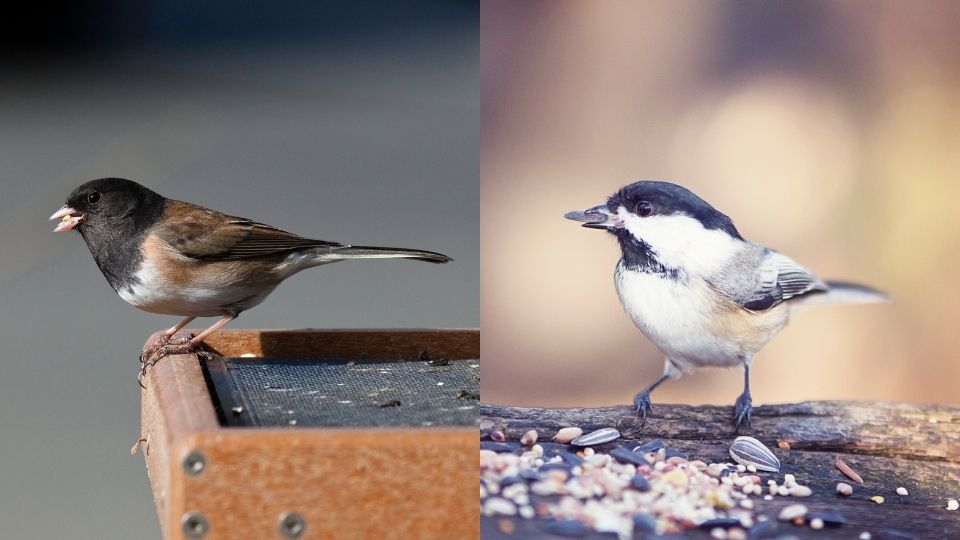
Diet
Chickadee – The diet of the Chickadee is surprisingly vast. A chickadee will eat anything from offerings from backyard feeders (like sunflower seeds and suet) to berries, nuts, and even carrion in some cases.
A Chickadee’s diet consists primarily of bugs like caterpillars, crickets, and other insects in the warm summer months. When food is scarce during the winter season, they munch on birdfeeder offerings and decaying animals.
Junco – The diet of a Junco is almost identical to a Chickadee. If identifying them wasn’t challenging enough, these two songbirds often hang out together around backyard feeders- especially in the wintertime.
In the summer, juncos eat bugs and spiders; in the winter, they dine on weeds, grasses, and seeds from feeders. The only difference in diet is that Juncos aren’t known to eat carrion.
Songs
Chickadee – Even for birdwatching novices, the Chickadee’s classic dee-dee-dee song is recognizable. Chickadees will often chirp and dwell closer to the ground, than other songbirds that typically perch on trees. Often, you can hear a Chickadee before you see it!
The dee-dee-dee bird call is a way for other chickadees to communicate with each other, and it’s also used as a mating call. Sometimes it means a predator nearby; other times, it’s a way to signify a good watering hole to other nearby birds.
Junco – The song of the Dark-eyed junco is much higher pitched than the chickadee. Junco calls consist of a trill of up to 20 notes and span a 2-second period. They often have fast trills when flying or warning of predators and slower pitched trills when foraging for food sources. These songs are very similar to the pitch of a House Sparrow or a Warbler.
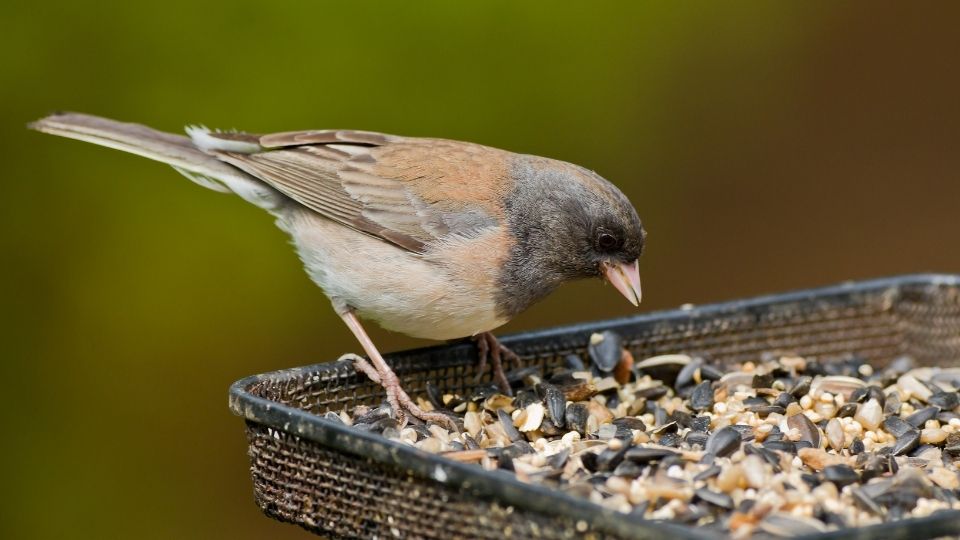
Difficulties Spotting Juncos
The problem with juncos is that there are many different subspecies, and each subspecies looks a little bit different. There are 13 other subspecies of the junco species, which all look wildly different.
The Oregon junco, for instance, has a similar black head with traces of rust-colored feathers near the bottom of its feathers. The Gray-headed junco has gray downy feathers on its breast and touches of orange on its wings.
One of the most confusing juncos is the Pink-sided junco. It doesn’t have any of the hallmarks of any other junco in its subspecies. It appears as a cross between a House Finch and a House Sparrow – but it is a junco!
The most common species of junco is the North American Dark-eyed junco, so learning their coloring and patterns is a great way to tell the difference between Chickadees and Juncos.
